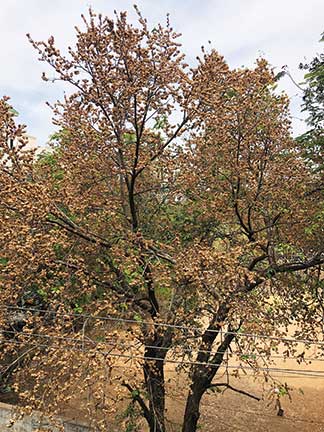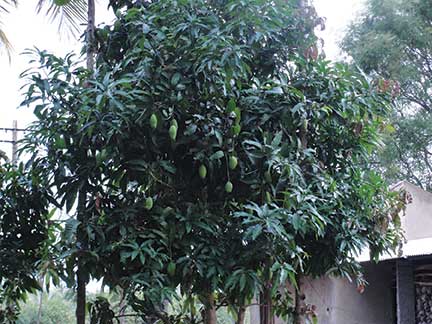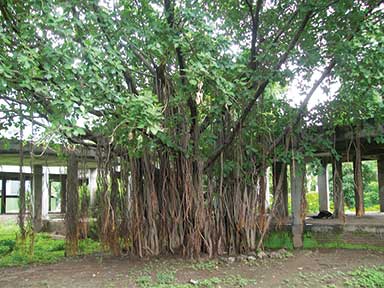Venkata Tejah Balantrapu
For 10 years now, I have been watching and noticing the seasonal patterns of a tall and unassuming tree outside our apartment: an Indian elm. They can be inconspicuous. Interspersed between rows of copper-pods and gulmohars on Hyderabadi roads, it is easy to miss this large and leafy species. The Indian elm is a tall and beautiful tree; the specimen I see daily is three storeys tall. For a few weeks in the year it is the Cinderella of the cityscape, shedding its dark green leaves and donning a spectacular canopy of light, bright green seed-pods instead. In a few weeks, as the magic hour approaches, the pods turn brown, shake loose and fly away. The tree grows a fresh set of lush, green leaves and fades into the background.

If you notice trees, it is hard to miss the Indian elm (Holoptelea integrifolia) in the last weeks of February. As winter ends, Deccani deciduous trees prepare for the long, dry summer before the monsoons set in by the end of June. This cycle sets off a variety of flowering adaptations among these trees. The Indian elm’s flowers are in-conspicuous, but its adaptation prefers to focus on the seed: the entire canopy is transformed and it looks as if the tree has a completely new kind of ‘leaf’ (they are seeds). After a few weeks, the seed-pods turn brown and dry, the tree sheds these pods and sprouts new leaves. However, I have found that the Indian elms in Hyderabad are erratic. Some quickly transition from old leaf, to seed, to new leaf. Others linger for weeks in the seed-phase, the dried-out coppery seeds quivering in the breeze. I have noticed big differences in this transition between elms that are only meters apart. It is fascinating to ponder over this adaptation in deciduous trees and how fungible and sensitive they are to available resources.
Cities in particular distort these ancient patterns of response to the climate cycle. Hyderabad is an artificial ‘island’ of tall, green trees in a vast and dry scrub-land of stunted trees and grasses. Human habitations, and modern cities in particular, draw water in from large distances. Municipal bodies, and individual homeowners, expend effort to water the grounds they control. Concrete, road, and other human actions alter the hydrology of a place, changing water tables and the flow of water. Naturally, this impacts trees and their cycles. Hyderabad’s trees are also imprints of human migrations. It is home to British colonial staples like the bougainvillea or the gulmohar. You can also find a smattering of baobabs here. When did they come? With the Siddis, East African soldiers invited here by the Asaf Jahis, or an older group of merchant caravans? Turns out, even the ubiquitous tamarind came here in ancient times. Would these trees survive in the dry Deccan landscape and the poor soil around Hyderabad? Hard to imagine. The palash looks like a stunted plant for years, sometimes even a decade, before it becomes a tree with adequate height and girth in the Deccan wilds. Deccan trees must account for the poor soil and availability of water, and the monsoons are their best bet. Trees inside the city limits have better access to water, perhaps, but 400-year-old Hyderabad is still too young to impact patterns ingrained in these trees’ life-cycles. Monsoons matter.
Pradip Krishen writes that a variety of deciduous Central Indian trees are adapted to an “intense pulse of rainy weather, with the rest of the year remaining mostly dry”. Take the spectacular palash (Butea monosperma) that we can find on the outskirts of Hyderabad. It too sheds its leaves around February-March and sprouts tongues-of-flame-like flowers on its bare branches. The lesser-known but equally spectacular Indian coral tree (Erythrina variegata) does the same thing – sheds all leaves and sprouts beautiful, ‘come-hither-birds’ flowers. Shedding halts transpiration and conserves water during the dry season. These trees quickly invest these resources in sprouting flowers, then seed, and drop them just as winter ends. If the seeds survive a few hot months, the rains arrive and the seeds can take root. This dance is tightly tuned to the monsoons and the dry weather preceding their arrival. The elm’s rhythms though, are more relaxed, more Hyderabadi. It seems to be flexible enough to alter its shedding cycle based on available resources.
Summers in Hyderabad are different from the forests of the Deccan and its trees have access to other water sources during that difficult period. There are other constraints though, like the restricted space for a tree between the road and side-walk. Overhead power lines lead to ugly ‘hair-cuts’ by the electricity department. Canopies are haphazardly chopped due to a desire for unrestricted view of a building’s facade, even to submit to superstition. An Indian elm must survive all these threats to its life. The ancient pressures of access to water, sunlight, and nutrients add to the risks it must face. The elm has to deal with more: it does not have the benefit of offering fruit to humans, curtailing its utility. Its bark is knotty and scabrous and is believed to have medicinal value – but not for city-dwellers who have access to Ayurvedic medical shops. So, why do they survive human apathy in the city? I do not know and can only be thankful for their presence. Tree-loving humans are not the Indian elm’s only fans. During the summer months every year, a family of monkeys traverse across the apartment walls in our colony, following some ancient track that we have built our houses over. The Indian elm outside my apartment is a traditional stop. Its thick trunk, splits into two, a foot off ground level. The two conjoined lines are solid, rough and patchy, and give off many distributary branches that further splinter into terminals of leaf/seed. The younger monkeys in the brood spend time on the elm, munching its seed-pods (‘monkey chips’ as my sons would call them when they were younger), playing, rattling, and shaking its canopy for a few minutes. Soon, the dogs and humans in the apartment become nervous. A steady barking, hooting, and stick-beating begins, and the monkeys know they are unwelcome. They swing away, further down that bygone trail. Over a few decades, this tree grew to become a point, a way-station, where a generation of monkeys have learnt to stop. To see a tree is to recognize a node on an old matrix of events and memories for all of life. Human children too have memories of tree-climbing and fruit-picking, though increasingly less so, as our urban lives reduce access to trees.

Courtesy: www.wikipedia.org
I grew up in the city without knowing its trees, indeed being unaware of my tree-blindness. For many years, trees meant a shade of green, a source of shade during hot summer months and not much else. As a kid, I knew all the houses on my street, the kids in them, the scooters or motorcycles their fathers drove, the books some of them owned, but not the trees that dotted the place. The two trees that stepped out from this veil of ignorance were the coconut (Cocos nucifera) in some of the houses and the mango (Mangifera indica) in the juvenile correction centre at the far end of the street. That poor mango tree had kids pelting it for fruit from two sides of a high brick wall. Looking back, there were so many other trees: gulmohar (Delonix regia), copper-pod (Peltophorum pterocarpum), kadamb (Neolamarckia cadamba), even flowering trees and plants like the pārijata (Nyctanthes arbor-tristis), tulasi (Ocimum tenuiflorum), hibiscus (Hibiscus rosa-sinensis), the frangipani (Plumeria), bougain-villea and a myriad roses. Some houses grew papaya (Carica papaya) to meet their needs for dietary fibre. A friend’s house had guava (Psidium guajava) that my friends loved to eat, but I would stay away from. I liked fuller ones from the market, preferably with salt and powdered chilli. I stayed away from the gustatory pleasures of the jackfruit, the sitaphal, the banana (the small and sweet chakkerakeli) and other fruit sold on push-carts at the street corner for I detested their pungent scent. A city street had a rich floral diversity for those willing to see. However, I had taken no notice of them and sometimes actively shut them away for years. The cityscape meant buildings and people, not trees and plants. As a young adult, I have eaten at food-stalls and chat bhandars under massive banyans (Ficus benghalensis) without once looking up. I have been dragged to many a temple and made pradakshinas around the trees in them, almost always a peepal (Ficus religiosa), without knowing why and what tree I was praying to.

Courtesy: www.wikipedia.org
All this changed with parenthood. When one is charged with the custody of a young person, it is difficult to let the world pass you by without examination. I began to take notice of things that interested my toddler sons and tried to look at the world from their fresh perspectives. Slowly, a new world opened up. With children, it is difficult to be a hypocrite. I must eat the fruit I expect them to eat. When down with a fever, the coconut is a source of rehydration and relief; I know it and accept it with grace, so my sons see and learn (I hope). With adults, and perhaps with my boys too, the stomach is one way to accept the trees around us. The first time we took our eldest son to a park he refused to walk on the grass, preferring the solidity of the tiled path. I had to sit on the grass and slowly coax him to shed his fears. Eventually, we walked around, touching the grass, pulling it out in tiny clumps and blowing it into the wind. Simple questions showed me I had no answers – what is that tree? Why is it so rough to touch? Why is this short while that is tall? My sons taught me to ask some fundamental questions, and then pushed me to seek answers for their sake.
Like me, my sons won’t be climbing trees like the tamarind (Tamarindus indica) or the neem (Azadirachta indica). But we do join walks in the parks of the city, and with them, I learn to recognize the silvery bark of a young Arjuna – ‘the white one’ – tree (Terminalia arjuna), or the palmate leaf structure of the Saptaparni (Alstonia scholaris). Together, we try to differentiate the common trees on Hyderabad’s roads as we go shopping, or meet friends. The hardest to pick out, especially when it’s not full of its spectacular seed-pods, is the Indian elm. I know there are a couple of elms on the old Mint road. There is one hiding in plain sight opposite the NMDC building off Masab tank. A few scattered around the roads of the Osmania University. An Indian elm is not meant to be sighted from a speeding car, it must be observed with patience, over time. The elm is a Hyderabadi tree.
The city is changing, but so is the climate. Overnight, decades-old trees are chopped away to make space for expanding roads. As we conceive of cities that are modern and futuristic, old trees are like old buildings; memories of a past we want to leave behind. Municipal bodies bring in new and exotic species of trees so that our cities look like those from the far west, and perhaps, the far future. Trees, like banner ads and cinema posters, are expected to pop up when necessary and translocate when not. But cities are vast spaces, folding, twisting into streets, lanes and by-lanes. It is hard to keep track, and slipping through the cracks, I have hope that many trees will survive our blindness. When my sons are older, and I am gone, these trees will remain as markers of this time and this space. When they grow up and move out, I hope my sons will remember our apartment opposite the Indian elm tree.
The author is a writer and communications professional from Hyderabad. He is learning to spend time with trees, to recognize them on city roads, and to try and save them so that his sons can grow up in a city full of trees too. He can be reached at tejahb@gmail.com.
